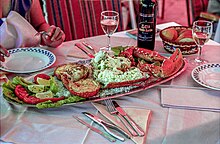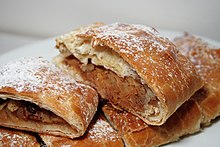
| Part of a series on the |
| Culture of Croatia |
|---|
 |
| History |
| People |
| Languages |
| Traditions |
| Mythology |
| Cuisine |
| Festivals |
| Religion |
| Art |
| Literature |
| Music and performing arts |
| Media |
| Sport |
| Monuments |
| Symbols |
| Organisations |
Croatian cuisine is heterogeneous and is known as a cuisine of the regions, since every region of Croatia has its own distinct culinary tradition. Its roots date back to ancient times. The differences in the selection of foodstuffs and forms of cooking are most notable between those in mainland and those in coastal regions. Mainland cuisine is more characterized by Slavic features and influences from the more recent contacts with Turkish, Hungarian and Austrian cuisine, using lard for cooking, and spices such as black pepper, paprika, and garlic. The coastal region bears the influences of Greek and Roman cuisine, as well as of the later Mediterranean cuisine, in particular Italian (especially Venetian). Coastal cuisines use olive oil, herbs and spices such as rosemary, sage, bay leaf, oregano, marjoram, cinnamon, clove, nutmeg, and lemon and orange rind. Peasant cooking traditions are based on imaginative variations of several basic ingredients (cereals, dairy products, meat, fish, vegetables, nuts) and cooking procedures (stewing, grilling, roasting, baking), while bourgeois cuisine involves more complicated procedures and use of selected herbs and spices. Charcuterie is part of the Croatian culinary tradition in all regions. Food and recipes from other former Yugoslav countries are also popular in Croatia.
Croatian cuisine can be divided into several distinct cuisines (Dalmatia, Dubrovnik, Gorski Kotar, Istria, Lika, Međimurje, Podravina, Slavonija, Zagorje) each of which has specific cooking traditions, characteristic of the area and not necessarily well known in other parts of Croatia. Most dishes, however, can be found all across the country, with local variants.
Meat and game
- Specialities from the grill are called s roštilja, those roasted on the spit s ražnja
- pečeno means roasted
- prženo means fried
- pod pekom means that the dish has been put into a stone oven under a metal cover. The cook puts hot coals on the cover so that the meal is cooked slowly in its own juices. Specialties cooked pod pekom include lamb, veal, and octopus.
- na lešo means boiled in broth or water (lamb, beef, fish)


Croatian meat-based dishes include:
|
|
Seafood

Croatian seafood dishes include:
|
|
Stews
Stewed vegetables with a small amount of meat or sausages (varivo or čušpajz) is perceived as a healthy, traditional meal. Sour cream (in Northern Croatia) or olive oil (on the coast) can be added to the plate just before serving. Stewed meat dishes are often prepared by men in open spaces, following hunting and shepherding traditions. In Dalmatian urban cuisine, spices such as cinnamon and clove, Swiss chard (known as "blitva"), dried plums, dried figs, apples and other fruit are sometimes added to meat stews.
|
|
Pasta

Pasta is one of the most popular food items in Croatian cuisine, especially in the region of Dalmatia. Manistra na pome (pasta with tomato sauce) is a staple. The other popular sauces include creamy mushroom sauce, minced meat sauce and many others. Fresh pasta (rezanci, krpice) is added to soups and stews, or prepared with cottage cheese, cabbage, even with walnuts or poppy seed. Potato dough is popular, not only for making njoki (gnocchi), but also for making plum or cheese dumplings which are boiled, and then quickly fried in breadcrumbs and butter.
|
|
Soups
Soup is an integral part of a meal in Croatia and no Sunday family meal or any special occasion will go without it. The most popular soups are broth-based, with added pasta or semolina dumplings. They are usually light in order to leave space for the main course and dessert to follow. However, cream or roux-based soups are also popular, and there are many local variations of traditional soups. In Dalmatia, fish soup with fish chunks, carrots and rice is commonly served.
- Maneštra
- Veal soup with smoked meat
- Beef broth with vermicelli pasta
- Mushroom soup, especially with porcini
- Dill soup
- Zagorska juha with porcini mushrooms, bacon, sweet pepper
- Pretepena juha od graha, beans cream soup
- Prežgana juha
- Chicken soup
Side dishes
- Sataraš (sliced and stewed summer vegetables)
- Mlinci (typical northwest Croatian roasted flatbread, similar to Caucasian flatbreads)
- Đuveč (baked summer vegetables, similar to ratatouille)
- Knedle (boiled dumplings)
- Mišanca (mix of wild plants and herbs)
Other



|
|
Sausages and ham
|
|
Cheese (sir)
- Paški sir – sheep's milk cheese from the island of Pag
- Farmers' cheese (škripavac) and curd cheese from the regions of Kordun and Lika
- Cheese from the Cetina region (Cetinski sir)
- Cheese from the Island of Krk (Krčki sir)
- Cheese from Međimurje (turoš)
- Cheese from Podravina (prga)
- Cottage cheese (eaten with cream, vrhnje) from Zagorje (sir i vrhnje, often seen as quintessential Croatian traditional food)
Savoury pies

- Viška pogača is a salted sardine-filled focaccia from the island of Vis.
- Soparnik is a Dalmatian chard-filled pie.
- Duvanjska pita, made from thin phyllo dough wraps filled with potato and meat.
Pastry





- Bučnica (summer squash and cottage cheese pie, can be savory or sweet)
- Štrukli (made with cottage cheese, sour cream and eggs, can be savory or sweet, boiled or baked)
- Zlevanka, simple baked cornmeal pastry with various fillings (e.g. cheese, sour cream, cherries, plum jam, walnuts, nettle)
- Varaždinski klipići
Sweets and desserts
- Palačinke (crepes) with sweet filling (Hungarian: palacsinta, German: Palatschinken)
- Piškote/Piškoti — thin, light, sweet delicate, crispy cookie
- Baklava
- Kremšnita – vanilla slice or custard slice, is a custard and chantilly cream cream cake dessert
- Doboš — sponge cake layered with chocolate buttercream and topped with caramel (Hungarian: Dobos torta)
- Šaumšnita –
- Zagorski štrukli – sweet pastry from northern Croatia
- Uštipci
- Fritule
- Knedle – also known as gomboce are potato dough dumplings, usually filled with plums and rolled into buttered breadcrumbs
- Strudel (Croatian: savijača or štrudla) with apple or curd cheese fillings
- Orahnjača and Makovnjača – sweet breads with walnut or poppy seeds
- Croatian honey
- Bear's paw
- Farmer's cheese (quark) cakes (cream cake)
- Krafne, pokladnice – a type of doughnut
- Croatian pancakes (with wine and egg sauce)
- Šnenokli, paradižot (meringue in custard cream, floating island (dessert))
- Almond filled ravioli (rafioli)
- Homemade fruit preserves, jams, compotes
- Čupavci (lamingtons)
- Tiramisu
Cakes (kolači)
- Rožata or Rozata (flan, creme caramel)
- Easter pastry Pinca
- Kroštule (crunchy, deep-fried pastry)
- Fritule (deep-fried dough, festive pastry, particularly for Christmas)
- Bishop's bread
- Guglhupf ring cake (Croatian kuglof)
- Rapska torta (Rab cake)
- Međimurska gibanica (Međimurje County layer cake with apple, poppyseed, walnut and cottage cheese fillings)
- Makarana torta
- Imotska torta
- Mađarica (Croatian layer cake)
Drinks
Wines
Main article: Croatian wineCroatia has 3 main wine regions: Continental (Kontinetska), Coastal (Primorska) which includes the islands and Slavonia.Croatia’s northeastern-most region.The old wine cellars in Ilok date back to the 15th and 18th centuries. It is interesting that the famous Ilok Traminac was ordered by the English Court for the coronation of Queen Elizabeth II. Also, one interesting story coming from one of the employees who save a place during the Homeland War, more precisely during the Serbian occupation of Ilok, when he decided to enclose the wall of one part of the Old Cellar and store it as many as 8,000 most valuable archival wines.
Each of the main regions is divided into sub-regions which are divided yet further into smaller vinogorje, (literally "wine hills") and districts. Altogether, there are more than 300 geographically defined wine-producing areas in Croatia.Istria, Konavle and Pelješac were recognised by Vogue as the best ones in Croatia. There are numerous enological events (fairs) throuought the year (for ex. Vinistra).
In parts of Croatia, wine, either red or white, is sometimes consumed mixed with mineral water or juices. For example, in Hrvatsko zagorje and Međimurje, popular combination is white wine and mineral water (mostly Jamnica), called gemišt (German: gemischt, ”mixed”, "mixture"). On the other hand, in Dalmatia is popular bevanda (Italian: bevanda, "drink"), mix of vine and natural water. Bevanda is common gastronomical motif in cultural representations of Dalmatia and its people in popular culture.
Dessert wines
- Sweet Malvazija
- Muškat Ottonel (see: Muscat grape)
- Prošek
- Traminac
White wines
- Rajnski Rizling
- Žlahtina, Vitis vinifera from Vrbnik (Vrbnik polje) at the Krk island, also known as "Vrbnička žlahtina”
- Malvazija
- Graševina
Red wines
Beers (pivo)

Apart from imported beers (Heineken, Tuborg, Gösser, Stella Artois, etc.), there are home-brewed and locally brewed beers in Croatia. A brewery based in Split produces Bavarian Kaltenberg beer by licence of the original brewery in Germany.
- Karlovačko: brewed in Karlovac
- Ožujsko: brewed in Zagreb (the name refers to the month of March)
- Pan
- Favorit: from Buzet, Istria
- Vukovarsko: from Vukovar
- Osječko: from Osijek (oldest brewery in Croatia)
- Tars pivo: from the seaport city of Rijeka
- Tomislav: dark beer from Zagreb
- Velebitsko pivo: brewed near Gospić on the Velebit mountain, the dark beer has been voted best beer by an English beer fan website.
Recent craft beer breweries are:
- Medvedgrad Brewery, from Zagreb, established in 1994
- Grif microbrewery, Zagreb
Liqueurs and spirits

- Maraschino
- Rakija (Croatian name for spirits), commonly made from: Lozovača / Loza (grapes) (it.: Grappa),Travarica (Loza with herbs), Šljivovica (plums), Kruškovac (pears), Drenovac (cherries)
- Pelinkovac
- Orahovac (walnut liqueur)
- Medovina (honey)
- Gvirc (as Medovina, only more alcohol).
Coffee
Croatia is a country of coffee drinkers (on average 5kg per person annually), not only because it was formerly part of the Austrian-Hungarian Empire, but also because it bordered the former Ottoman Empire. Traditional coffee houses similar to those in Vienna are located throughout Croatia.
Mineral water
Regarding its water resources, Croatia has a leading position in Europe. Concerning water quality, Croatian water is greatly appreciated all over the world. Due to a lack of established industries there have also been no major incidents of water pollution.
- Jamnica – Winner of the Paris AquaExpo for best mineral water of 2003
- Lipički studenac
- Jana – also belongs to Jamnica, best aromatized mineral water (Eauscar 2004)
Juices and syrups
|
|
|
Protected products
There are 46 Croatian agricultural and food products whose name is registered in the European Union as a protected designation of origin or a protected designation of geographical origin (European mark of authenticity by the European Commission).
- Cheese
- Bjelovarski Kvargl
- Lički škripavac (from Lika)
- Pag cheese (from Pag island)
- Honey
- Goranski medun (from Gorski kotar)
- Slavonski med (Slavonian honey)
- Zagorski bagremov med (from Hrvatsko zagorje)
- Meat
- Baranjski kulen
- Dalmatinska janjetina (Dalmatian lamb)
- Dalmatinska panceta
- Dalmatinska pečenica
- Dalmatinski pršut
- Drniški pršut
- Istarski pršut (Istrski pršut)
- Lička janjetina (Likan lamb)
- Krčki pršut
- Malostonska kamenica
- Međimursko meso ‘z tiblice
- Meso istarskog goveda – boškarina (Meso istrskega goveda – boškarina; Meat of Istrian cattle – Boškarin)
- Paška janjetina (lamb from Pag island)
- Samoborska češnjovka (Samoborska češnofka; smoked saussage from Samobor)
- Slavonska crna svinja (Slavonian black pig, hr)
- Slavonski kulen (Slavonski kulin; Slavonian kulen/kulin)
- Zagorski puran (turkey meat from Hrvatsko zagorje)
- Fruits and vegetables
- Brački varenik
- Neretvanska mandarina
- Komiški rogač (Komižan carob)
- Lički krumpir (Likan potato)
- Ogulinsko kiselo zelje/Ogulinski kiseli kupus
- Varaždinsko zelje
- Olive oils
- Bračko maslinovo ulje
- Ekstra djevičansko maslinovo ulje Cres
- Korčulansko maslinovo ulje
- Krčko maslinovo ulje
- Šoltansko maslinovo ulje
- Other oils
- Varaždinsko bučino ulje (Varaždin pumpkin seed oil)
- Pastry
- Lumblija (aromatic sweet bread)
- Poljički soparnik (Poljički zeljanik or Poljički uljenjak)
- Rudarska greblica
- Varaždinski klipič
- Zagorski mlinci
- Zagorski štrukli (Zagorski štruklji)
- Sea products
- Novigrad Mussel, Mytilus galloprovincialis cultivated in farms in the Novigrad Sea and Novsko Ždrilo
- Paška sol (sea salt from Pag island)
See also
References
- "Origin". Absolute Croatia. Retrieved 22 May 2019.
- "Croatian Cuisine Guide: Amazing Croatian Foods You Must Try". CroatiaWise. 14 June 2018. Retrieved 22 May 2019.
- ^ Dalmatian lamb gets name protection in Europe becoming the 40th product from Croatia Croatia Week. Published March 8, 2023.
- Bizarre Foods with Andrew Zimmern – Croatia's Dalmatian Coast (youtube) (video). TravelChannelShows. 2015-10-07. Event occurs at 42:34. Archived from the original on 2021-12-12.
- Bizarre Foods - Croatia - Dalmatian Coast. Archived from the original on 2017-02-05.
- "Croatia's Dalmatian Coast: Roasted Rodents & Stone Soup". Travel Channel.
- "Blitva – Queen of the Dalmatian garden". croatiaweek.com. Croatia Week. 5 August 2023. Retrieved 20 August 2023.
- Eskins, Julia: Move Over, Tuscany: Why Croatia’s Wine Regions Should Be on Your Radar vogue.com. Vogue. Published 13 February 2023. Access date 19 May 2023.
- Istrian wine scene impresses yet again croatiaweek.com. Croatia Week. Published 7 May 2023. Access date 19 May 2023.
- Jakopec, Marta (2015). Production and basic quality parameters analyses of domestic white wine from Hrvatsko zagorje University of Zagreb, Faculty of Food Technology and Biotechnology, p. 12.
- Kodba, Alen (2019). Role and importance of interesting associations of participants for the development of wine turism of Međimurje University of Zagreb, Faculty of Economics and Business, p. 22
- gèmišt hjp.znanje.hr. Croatian language portal. Access date 19 May 2023.
- bèvānda hjp.znanje.hr. Croatian language portal. Access date 19 May 2023.
- Malek, Lina; Lovrić, Tena (2021). Slika Dalmacije u glazbenim spotovimana Youtubeu i njihova uloga u medijskoj prezentaciji Dalmacije Communication Management Review, 6 (2), 71.
- Smokvina, Martina (2022). UVJETI UZGOJA I KARAKTERISTIKE VINA SORTE ŽLAHTINA (Vitis vinifera L.) U VRBNIČKOM POLJU (Thesis) (in Croatian). Rijeka: Veleičilište u Rijeci. Retrieved 29 June 2023.
- "Maraska". Maraska.hr. Archived from the original on 2007-08-10. Retrieved 2012-06-20.
- "Badel 1862". Badel1862.hr. 2012-02-14. Archived from the original on 2010-02-17. Retrieved 2012-06-20.
- "Cedevita | Home". Cedevita.hr. Archived from the original on 2015-05-25. Retrieved 2015-11-13.
- ^ "Meso crne slavonske svinje postalo 46. hrvatski proizvod zaštićenog naziva". vijesti.hrt.hr (in Croatian). Croatian Radiotelevision. 12 December 2023. Retrieved 13 December 2023.
- Bjelovarski Kvargl tasteatlas.com
- Bjelovarski kvargl/Bjelovar Kvargl timeout.com
- "Special "Goranski Medun" honey from Croatia gets EU protection status". croatiaweek.com. Croatia Week. February 13, 2023.
- ^ "3 more Croatian food and agricultural products get origin protection". croatiaweek.com. Croatia Week. November 23, 2022.
- Komiški rogač becomes 42nd protected Croatian product croatiaweek.com. Croatia Week. Published March 30, 2023.
- Varaždin pumpkin seed oil entered in EU register of protected designations of origin croatiaweek.com. Croatia Week. Published 4 July 2023. Access date 4 July 2023.
- Lumblija tasteatlas.com
- "Novigrad Mussel becomes 43rd Croatian product protected". Croatia Week. 28 June 2023. Retrieved 28 June 2023.
Further reading
- "Hrvatska za stolom – mirisi i okusi Hrvatske", Ivanka Biluš et al., Zagreb:Alfa, Koprivnica: Podravka, 1996, 192 p., illustrated in color, (Biblioteka Anima Croatarum, 2) ISBN 953-168-104-X
- "Hrvatska vina" (Croatian wines), Fazinić Nevenko, Milat Vinko, illustrated, 159 p., 1994, ISBN 953-173-061-X
- "Nova hrvatska kuhinja" (New Croatian cuisine), Davor Butković, Ana Ugarković, Profil international, Zagreb, 2005, 272 p., ISBN 953-12-0164-1
- Callec, Christian (2003), written at The Netherlands, Wine: A Comprehensive Look at the World's Best Wine, New York: Random House (published 2002), ISBN 0-517-22165-9.
| Cuisines | |||||||||||||
|---|---|---|---|---|---|---|---|---|---|---|---|---|---|
| Continental |
| ||||||||||||
| National and regional |
| ||||||||||||
| Ethnic |
| ||||||||||||
| Religious | |||||||||||||
| Historical |
| ||||||||||||
| Styles | |||||||||||||
| Lists | |||||||||||||
| Related | |||||||||||||
| Mediterranean cuisine | |||||||||||||||||||||||||||||
|---|---|---|---|---|---|---|---|---|---|---|---|---|---|---|---|---|---|---|---|---|---|---|---|---|---|---|---|---|---|
| Regions |
| ||||||||||||||||||||||||||||
| Staples | |||||||||||||||||||||||||||||
| Shared | |||||||||||||||||||||||||||||
| Exemplars | |||||||||||||||||||||||||||||
| European cuisine | |||||
|---|---|---|---|---|---|
| Sovereign states |
| ||||
| States with limited recognition | |||||
| Dependencies and other territories | |||||